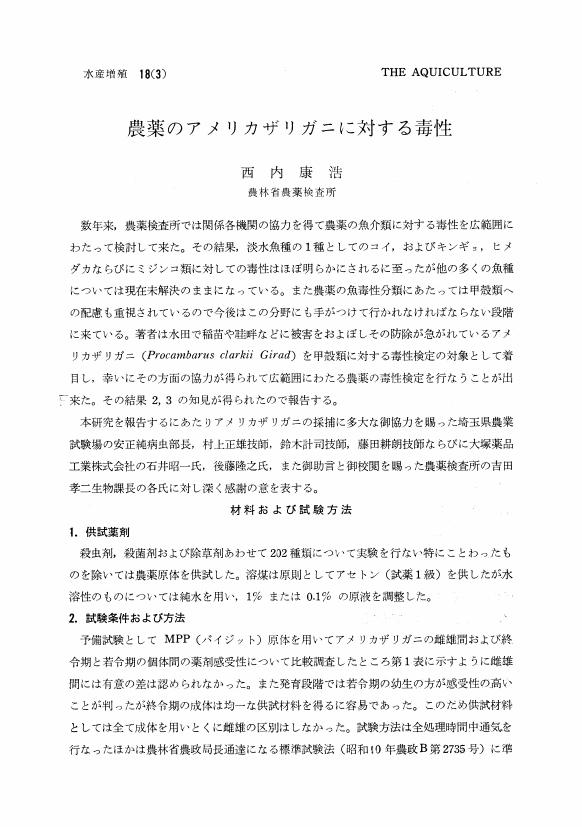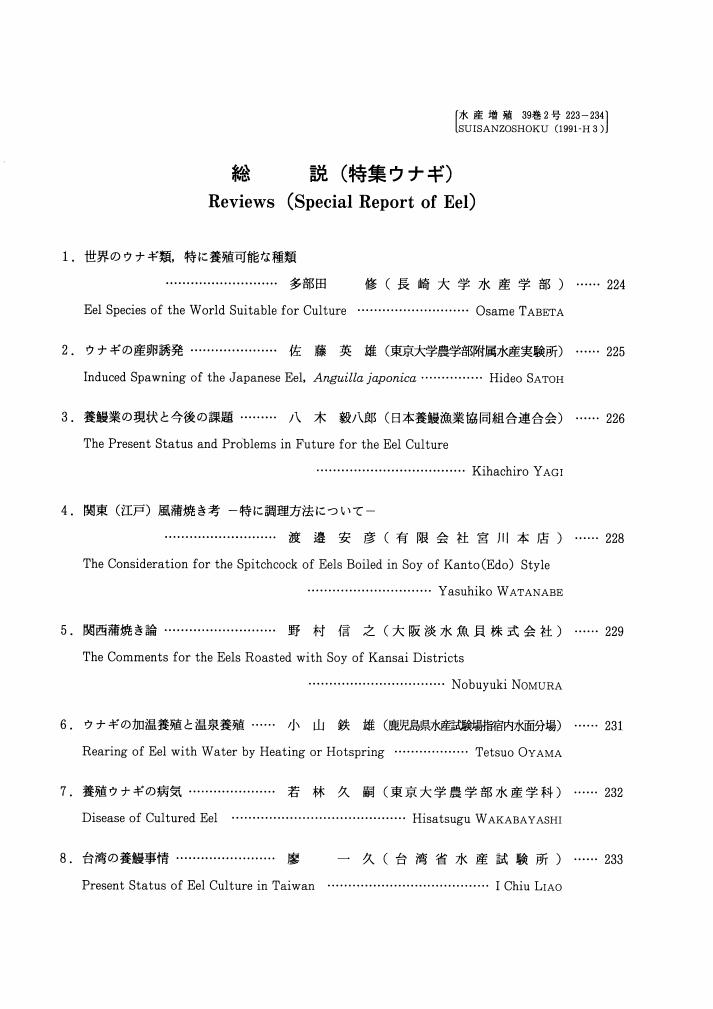1 0 0 0 OA フグの胃の膨張機構
- 著者
- 山元 憲一 半田 岳志
- 出版者
- Japanese Society for Aquaculture Science
- 雑誌
- 水産増殖 (ISSN:03714217)
- 巻号頁・発行日
- vol.60, no.1, pp.11-18, 2012-03-20 (Released:2015-03-23)
- 参考文献数
- 9
トラフグの口腔内圧,鰓腔内圧,口腔と鰓腔の圧差,胃内圧,口からの吸入水量,口からの排出水量および胃の膨張度合いを連続測定した。色素を鰓腔へ注入し,胃から採水して,水の移動を観察した。これらの結果から,鰓換水および胃の膨張機構を解析し,モデル化した。トラフグは,口腔内圧,鰓蓋内圧およ口腔と鰓腔の圧差を利用し,口腔弁,鰓蓋弁および食道括約筋を能動的に開閉することによって,胃の膨張および膨張からの収縮を行っていることが明らかとなった。
1 0 0 0 OA 山口県錦川にわけるアマゴの生態について
- 著者
- 藤村 治夫
- 出版者
- Japanese Society for Aquaculture Science
- 雑誌
- 水産増殖 (ISSN:03714217)
- 巻号頁・発行日
- vol.17, no.3, pp.101-112, 1970-02-10 (Released:2010-06-30)
- 参考文献数
- 10
1. 錦川上流域, 錦町付近に生息するアマゴについて得られた標本を調査し, その分布, 成長, 成熟およびアマゴ, 降海型アマゴ, 溯河マスの相互関係を明らかにした。2. 鱗による年令査定の結果, 年令の形成完了時期は11-12月で, 無輪のものは当才魚1輪のものは2年魚, 2輪のものは3年魚である。3. 降海型アマゴおよび溯河マスの各部形態, 鱗の形状および朱点を有する点でアマゴと差が認め難い。従ってこれら三者の関係は早栗によるサクラマスとヤマメの関係同様で, 溯河マス, アマゴの雌雄から降海型アマゴおよびアマゴがそれぞれ出現するものと考えられる。溯河マスは大島のビワマスの降海型と一致する。4. 降海型アマゴは満1年経過後の12-3月に産卵生息域である支流から錦川本流に降河し, 体表が銀白化する。このアマゴは5-7月に錦町付近に溯上しマスと呼ばれる。降河と溯河の時期から考えると海中生活の期間は2-3ケ月である。アマゴでも降下, 溯上は見られるが, 海までは降下しないと思われる。5. アマゴの成長は満1年で最大尾叉長16.3cm, 満2年で20cm, 2年6ケ月で24.0cmである。降海型アマゴでは満1年2ケ月で18cm, 1年8ケ月で30cmでニジマスより優れた成長を示す。6. アマゴならびに溯河マスの成熟は雌雄とも満2年であり, アマゴの雄では満1年で成熟するものもある。7. アマゴでは雌雄とも産卵放精後生き残るものがある。
1 0 0 0 OA 1.アユの分類学的位置
- 著者
- 岩井 保
- 出版者
- Japanese Society for Aquaculture Science
- 雑誌
- 水産増殖 (ISSN:03714217)
- 巻号頁・発行日
- vol.38, no.2, pp.199-200, 1990-06-30 (Released:2010-03-09)
- 参考文献数
- 4
1 0 0 0 OA ニホンイシガメ, Mauremys japonicaの皮膚糸状菌症について
- 著者
- 鎌田 篤 廣瀬 一美
- 出版者
- Japanese Society for Aquaculture Science
- 雑誌
- 水産増殖 (ISSN:03714217)
- 巻号頁・発行日
- vol.46, no.3, pp.377-378, 1998-09-20 (Released:2010-03-09)
- 参考文献数
- 5
A fungus was isolated from the regions of dermatomycosis on Japanese pond turtle, Mauremys japonica. The fungus was tentatively identified as Aphanomyces sp.of Saprolegniaceae. However, we could not define it at species level because the fungus did not produce any syngenetic organs. The optimal growth temperature for Aphanomyces sp. strain AK11 was estimated as 25-30°C. This is the first report of Aphanomyces sp. infection in Japanese pond turtle.
1 0 0 0 OA 飼育下におけるマダコの交接行動と複数父性
- 著者
- 高木 基裕 木村 真 坂口 秀雄
- 出版者
- 日本水産増殖学会
- 雑誌
- 水産増殖 (ISSN:03714217)
- 巻号頁・発行日
- vol.70, no.2, pp.131-140, 2022 (Released:2023-06-20)
- 参考文献数
- 17
マダコを陸上水槽で交接・産卵・孵化させ,親子鑑定により父性を推定し,繁殖生態を明らかにした。各試験において同一の水槽に雌雄を投入してから交接開始までは14~930秒,雌個体の産卵までは8~140日間,産卵開始から仔ダコのふ化が始まるまでは23~68日間,ふ化期間は6~24日間とそれぞれ期間の長さに差がみられた。雌雄の交接時間は283~6,277秒,雄のアーチ・ポンプの回数は5~25回と個体によって差がみられた。親子鑑定により,マダコにおける複数父性の存在が確認される一方,ふ化仔ダコに占める各父性の割合には差異が確認された。また,今回用いた雌の多くは自然海域ですでに複数の雄と交接し,精子を蓄えていた。各ふ化日ごとの仔ダコの父性の構成割合には大きな差異が見られなかったことから,雌と交接した各雄の精子は交接から産卵までに雌の体内でよく混ざっている可能性が考えられた。
1 0 0 0 OA 真珠に関する用語
- 著者
- 阿山 多喜也
- 出版者
- 日本水産増殖学会
- 雑誌
- 水産増殖 (ISSN:03714217)
- 巻号頁・発行日
- vol.3, no.4, pp.104-107, 1957-08-30 (Released:2010-06-30)
1 0 0 0 OA オオクチバスの成熟と催熟
- 著者
- 邱 嘉仁 酒井 清 隆島 史夫
- 出版者
- Japanese Society for Aquaculture Science
- 雑誌
- 水産増殖 (ISSN:03714217)
- 巻号頁・発行日
- vol.39, no.4, pp.343-351, 1991-12-15 (Released:2010-03-09)
- 参考文献数
- 16
- 被引用文献数
- 2
1988年9月から1989年8月までの間, 印旛沼におけるオオクチバスの産卵期, 卵形成過程および精子形成過程を組織学的に調べるとともに, LHRH-aによる催熟促進や低温処理による3倍体魚の作出を試み, 以下の結果を得た。1) 組織学的に本種の卵母細胞の発達過程は10期に分けられた。2) 組織学的に本種の精子形成の発達過程は3期に分けられた。3) 卵母細胞の発達様式は非同期発達型に属した。4) 産卵期は排卵痕の出現時間より4月下旬から6月上旬と推定された。5) 精子形成には春と秋の年2回のピークが認められた。6) 体重1kgあたり15~80μgのLHRH-aコレステロールペレットを腹腔内に投与することにより, 投与後31.5~55時間で排卵させることができた。7) 媒精後3~7分経過時に0℃の低温に受精卵を20~30分間浸漬することにより, 3倍体魚の作出が可能であった。
1 0 0 0 OA マコガレイの視感度特性の成長変化
- 著者
- 柴田 玲奈 宇都 康行 石橋 賢一
- 出版者
- 日本水産増殖学会
- 雑誌
- 水産増殖 (ISSN:03714217)
- 巻号頁・発行日
- vol.67, no.4, pp.313-318, 2019-12-20 (Released:2020-12-20)
- 参考文献数
- 33
マコガレイの稚魚,未成魚,成魚の分光視感度特性を調べるために,暗順応した供試魚の眼球から網膜電図(ERG)を記録した。得られた ERG のデータを Stavenga et al.(1993)のテンプレートに当てはめ分光応答曲線を求めた。稚魚,未成魚,成魚における最大応答波長はそれぞれ531 nm,524 nm,515 nm であり,すべてのステージで緑に感度が高いことが示された。マコガレイ稚魚は浅瀬に生息し,成長とともに生息水深が深くなる。分光感度ピーク波長が成長とともに短波長側にシフトすることは,生息水深の光環境への適応と推測された。
1 0 0 0 OA 人工ふ化飼育によるマハゼの卵発生と仔稚魚の発育過程
- 著者
- 鈴木 伸洋 柵瀬 信夫 杉原 拓郎
- 出版者
- Japanese Society for Aquaculture Science
- 雑誌
- 水産増殖 (ISSN:03714217)
- 巻号頁・発行日
- vol.36, no.4, pp.277-289, 1989-03-15 (Released:2010-09-07)
- 参考文献数
- 12
- 被引用文献数
- 3
Morphological development of the oriental goby, Acanthogobius flavimanus reared from eggs to juveniles in the laboratory at Sagami Bay, Japan is described. During mid February ovarian maturation is successfully induced by injection of the LH-releasing hormone of Gonadotropin. The dose of the hormone was 5IU/g body weight and was injected 4 times at an interval of one day for ovulation at water temperature of 12 to15°C. Artificial fertilization was accomplished on the first of March, 1985. The numberof ripe eggs removed artificially was about 25, 000. The eggs immediately after insemination are spherical in shape, measuring 0.99-1.10 mm in diameter. They have a bundle ofadhesive filaments at their basal end and a cluster of small oil globules. The egg membrane elongates to form a perivitelline space when the inflation ceases about 30 minutes after insemination. The eggs alter ellipsoid shape and measure about 3.93 mm on the long axis. Hatching began about 18 days after insemination at water temperature of 15.0-15.4°C. Soon before hatching, embryos fold down the tail at the basal end region of eggshell. The newly hatched larvae are 4.13-4.86 mm in total length (TL), with 31 (13+18) myomeres. The larvae usually lay on their body on the bottom of the aquarium. Many melanophores and guanophores are distributed on eye cups, gas bladder, intestine and in the caudal region. Complex of pigments form a band in the caudal region, but the band is never connected with the pigments on intestine. This character is not shared with larvae of A. hasta and A. lactipes. Seven days after hatching the yolk was completely absorbed and the larvae attained a total length of 5.73-6.10 mm.The larvae swim actively in the aquarium and start to practice feeding on the rotifer. Twenty days after hatching, the larvae averaged 9.01 mm in TL and the caudal notochord flex at 45°. Rudimental second dorsal, anal, caudal and ventral fins are also formed. The larvae attained 11.00-15.00 mm in TL, thirty five after hatching, are found to transit the bottom-life and first dorsal and ventral fins are completely formed. During the late postlarval stage, the fish is nervously to develop the free neuromast on the skin surface. The larvae reached the juvenile stage at 45-50 days after hatching and attained 13.85-24.90 mm in TL. At this period all scales appeared on the body. A clear black spot on the first dorsal fin is characteristic at the immature stage of the fish. The larvae and juveniles were reared by feeding them with the rotifers, Artemia nauplii, krill meat and lugworm meat for one year. The growth of larvae and juveniles in 1985 is expressed by the following equations.Y1=4.697×1.034x (0≤X≤45)Y2=0.716X-14.123 (46≤X≤170)Y3=160.18lnX-715.90 (171≤X≤330)where Y is the total length (mm) and X is number of days after hatching. The fish grew to 189.55-232.70 mm in TL and became mature in one year. Most of the individuals attained gonadal maturation and died after spawning.
1 0 0 0 OA 魚類の椎体数
- 著者
- 西内 康浩
- 出版者
- 日本水産増殖学会
- 雑誌
- 水産増殖 (ISSN:03714217)
- 巻号頁・発行日
- vol.22, no.1, pp.19, 1974-06-25 (Released:2010-03-09)
1 0 0 0 OA マシジミの生態に関する研究
- 著者
- 池末 弥 志垣 誠一
- 出版者
- Japanese Society for Aquaculture Science
- 雑誌
- 水産増殖 (ISSN:03714217)
- 巻号頁・発行日
- vol.24, no.2, pp.68-74, 1976-09-25 (Released:2010-03-10)
- 参考文献数
- 3
- 被引用文献数
- 2
マシジミの生租法, 特に排卵と保育幼生の放出状況および幼生生と卵生生に関して飼育実験を行ない, 次の点を明らかにした。1) 約6ヵ月の飼育期間中70%の個体が大量の体外排卵を行ない, さらにその20%が2回の排卵を行なった。飼育水温などの環境変化が排卵の刺激となるようであり, 個体の成熟盛期は少なくとも年2回あるが, 環境条件によっては周年生殖を行なうようである。2) 体外に排出された卵はすべて自家受精しており沈性卵, すみやかに卵発生が進み, 水温23-25℃では40-45時間でD型幼生になり, 浮遊期は全くみられず底生生活を行なう。3) 体外排卵と同時にその10-20%程度に相当する卵が母体に保育され, 3-5日までにD型幼生として放出される。その後は引続き少量ずつの排卵が起り, 体内に保育, 幼生になって放出される過程が約1ヵ月間も続く個体が多い。マシジミはこれまで幼生生の生殖を行なうとされていたが, 同時に卵生型の生殖法も行なっていることを確認した。4) 体外排卵数は1回1-5万, 放出幼生数は2-6千個程度で, 前者は後者の7-8倍にも達する。しかし, 何れが再生産に大きく貢献しているかは今後の研究にまたねばならない。
1 0 0 0 OA 海藻食魚の香気成分
- 著者
- 宮崎 泰幸 藤岡 侑祐
- 出版者
- Japanese Society for Aquaculture Science
- 雑誌
- 水産増殖 (ISSN:03714217)
- 巻号頁・発行日
- vol.60, no.2, pp.189-194, 2012-06-20 (Released:2015-03-23)
- 参考文献数
- 17
- 被引用文献数
- 3
海藻食性魚類の筋肉の香気成分を比較した。山口県下関市蓋井島の海岸で2008年12月に採取したアイゴ,2009年1月および5月に採取したメジナおよび鹿児島県中甑島で2008年12月に採取したアオブダイ,イスズミおよびニザダイを実験に用いた。普通筋香気成分を固相マイクロ抽出を用いたガスクロマトグラフィー質量分析装置および電子嗅覚装置で分析するとともに,香気強度の官能検査を行った。ほぼ同時期に採取した5魚種は EN 分析でそれぞれ異なる香気成分組成を示しており,その中でもヘキサナールを多く含むアイゴならびに 3-メチル-1-ブタナール,2-メチル-1-ブタナールおよび 3-メチル-1-ブタノールを多く含むアオブダイは特異的であった。また,採取時期の異なるメジナは互いに大きく異なる香気成分を示した。官能的にはメジナが最も香気が弱いと判断された。
1 0 0 0 OA 福井県のバフンウニの漁期における苦味を呈する生殖巣の出現
- 著者
- 仲野 大地 児玉 晃治 村田 裕子
- 出版者
- 日本水産増殖学会
- 雑誌
- 水産増殖 (ISSN:03714217)
- 巻号頁・発行日
- vol.69, no.3, pp.227-230, 2021 (Released:2022-09-20)
- 参考文献数
- 13
Bitter tasting gonads in the sea urchin Hemicentrotus pulcherrimus occurred in Fukui Prefecture during the fishing season in 2019. Bitterness was found only in female gonads, and pulcherrimine, a bitter tasting amino acid specific to female gonads, was detected in specimens. Relict ova was also observed in the ovary by tissue observation. We concluded presence of pulcherrimine in ovaries is the cause of bitterness in this study. A delayed spawning is likely to be associated with the occurrence of pulcherrimine.
1 0 0 0 OA 放流標識として切除したサクラマスの腹鰭および背鰭の再生
- 著者
- 田子 泰彦
- 出版者
- Japanese Society for Aquaculture Science
- 雑誌
- 水産増殖 (ISSN:03714217)
- 巻号頁・発行日
- vol.45, no.4, pp.479-483, 1997-12-20 (Released:2010-03-09)
- 参考文献数
- 7
大量放流用の標識として切除したサクラマスの背鰭及び腹鰭の再生状況を明らかにした。背鰭切除後約8~9カ月経過した群では, 再生が認められた個体割合は71.9~79.5%で, そのうちほぼ完全に再生した割合は5.2~27.7%であった。腹鰭切除後約8~9カ月経過した群では, 再生が認められた個体割合は50.7~86.4%で, そのうちほぼ完全に再生した割合は8.1~38.3%であった。鰭切除後約27~28カ月経過したサクラマス親魚では, 51.5%の腹鰭がほぼ完全に再生していた。これらの結果は, 背鰭や腹鰭標識によって放流した幼魚の回帰率は実際よりも低く算定されたことを示しており, 放流魚のより正確な回帰率を得るためには, 脂鰭切除標識に加えて耳石標識やCoded Wire Tagなどの内部標識を組み合わせて用いるべきだと考えられた。
1 0 0 0 OA 4. ストレス作用因子と魚類のストレス
- 著者
- 赤崎 正人
- 出版者
- Japanese Society for Aquaculture Science
- 雑誌
- 水産増殖 (ISSN:03714217)
- 巻号頁・発行日
- vol.38, no.3, pp.298-299, 1990-09-30 (Released:2010-03-09)
1 0 0 0 OA ヒラメ幼稚魚の生残, 成長および飼育環境に及ぼすアナアオサ変異種のフィードバック飼育効果
- 著者
- 許 波濤 平田 八郎
- 出版者
- Japanese Society for Aquaculture Science
- 雑誌
- 水産増殖 (ISSN:03714217)
- 巻号頁・発行日
- vol.40, no.2, pp.207-213, 1992-06-20 (Released:2010-03-09)
- 参考文献数
- 22
1) ヒラメ幼稚魚の生残, 成長, 飼育環境に及ぼすアナアオサ変異種のフィードバック効果を知るため, 供試魚とアオサの併用培養によるフィードバック投餌区 (A) , 無アオサ併用培養による無フィードバック区 (B) 及び毎日約85%ずつ自然海水と交換した海水交換区 (C) の3実験区を設定し, 22±1.0℃の恒温室で90日間にわたり飼育実験を行った。2) A・B・C区における実験によりは, ヒラメの生残率はそれぞれ92.9%, 14.3%および85.7%, 日間成長率はそれぞれ2.19%, 2.04%および2.17%, また, 飼料係数はそれぞれ0.95, 6.34および1.16であり, いずれもA区のほうがB・C区より優れた結果が得られた。3) A・B・C区における三態窒素およびPO4-Pの実験期間の平均濃度は, NH4-Nでそれぞれ4.4, 26.0および4.5, μg-at・l-1, NO2-Nでそれぞれ0.8, 8.5および1.1μg-at・l-1, NO3-Nでそれぞれ7.0, 35.3および5.8μg-at・l-1, またPO4-Pでそれぞれ3.8, 6.7および2.6μg-at・l-1であり, アオサの併用培養によるヒラメの飼育環境保全に効果が得られた。
1 0 0 0 OA 農薬のアメリカザリガニに対する毒性
- 著者
- 西内 康浩
- 出版者
- Japanese Society for Aquaculture Science
- 雑誌
- 水産増殖 (ISSN:03714217)
- 巻号頁・発行日
- vol.18, no.3, pp.121-132, 1970-08-30 (Released:2010-03-10)
- 参考文献数
- 8
1 0 0 0 OA 1.世界のウナギ類、特に養殖可能な種類
- 著者
- 多部田 修
- 出版者
- Japanese Society for Aquaculture Science
- 雑誌
- 水産増殖 (ISSN:03714217)
- 巻号頁・発行日
- vol.39, no.2, pp.224-225, 1991-06-30 (Released:2010-03-09)
- 参考文献数
- 9
1 0 0 0 OA アマモ種子における塩分および温度制御による発芽促進効果
- 著者
- 山木 克則 小河 久朗 吉川 東水 難波 信由
- 出版者
- Japanese Society for Aquaculture Science
- 雑誌
- 水産増殖 (ISSN:03714217)
- 巻号頁・発行日
- vol.54, no.3, pp.347-351, 2006-09-20 (Released:2010-03-09)
- 参考文献数
- 13
アマモ場の再生に向けたアマモの苗の大量生産に向けたシステムの構築を行うために, アマモの種子を短期間に高率で発芽させる条件を見出すために発芽試験を行った。試験に用いたアマモの種子は東北地方と関東地方の4産地で採取し, 20℃の暗黒条件下で2か月間保存したものを用いた。試験は, 塩分と温度を一定条件にした水溶液中で行った。塩分は0 (淡水) , 5, 10, 15, 20, 25, 33psu, 設定温度は5, 10, 15, 20℃とした。試験の結果, 全ての産地に共通して20℃の淡水条件 (0 psu) で高い発芽率が見られ, 10日間で60%以上であった。発芽種子をTTC溶液で染色したところ活性が見られた。しかし, 淡水浸漬14日以上では発芽種子に胚軸の生育阻害及び腐敗が見られ30日でほぼ全ての発芽種子が腐敗した。種子の保存期間と淡水による発芽促進効果の関係を調べるために種子の保存期間 (20℃) を1, 7, 21, 30, 60, 180, 360日として発芽試験を行った結果, 保存期間が長くなるほど発芽率が高くなる傾向を示し, 60日以上の保存期間で高い発芽率を示した。
1 0 0 0 OA 交雑魚ブリ×ヒラマサおよびカンパチ×ヒラマサ背側肉の化学成分組成
- 著者
- 村田 修 家戸 敬太郎 那須 敏朗 宮下 盛 和泉 健一 熊井 英水
- 出版者
- Japanese Society for Aquaculture Science
- 雑誌
- 水産増殖 (ISSN:03714217)
- 巻号頁・発行日
- vol.48, no.4, pp.677-678, 2000-12-20 (Released:2010-10-28)
- 参考文献数
- 6
- 被引用文献数
- 1
Chemical compositions of the dorsal muscle of hybrids, yellowtail, Seriola quinqueradiata _??_ × goldstriped amberjack S. aureovittata _??_ (termed as YG) and purplish amberjack S.dumerili_??_ × goldstriped amberjack _??_(termed as PG) were compared with each parents fish species. The lipid content of YG was remarkably higher than that of goldstriped amberjack. In collagen content concerning texture, though YG was lower than goldstriped amberjack, it was significantly higher than yellowtail. Crude protein, total extractive nitrogen and collagen content of PG showed the intermediate value of the parents fish species.





